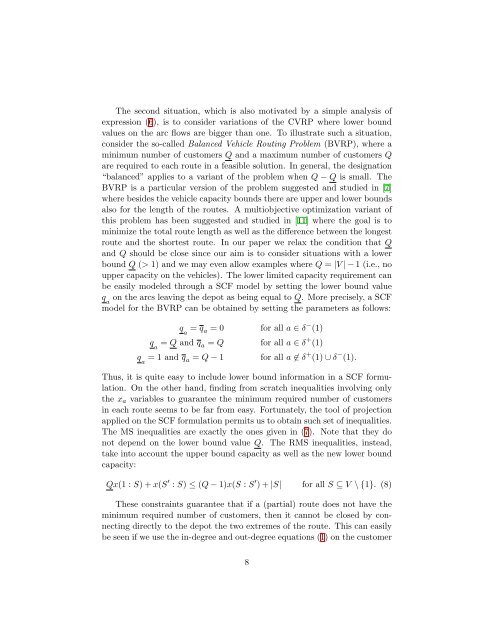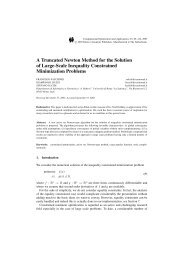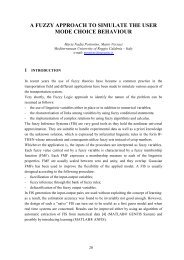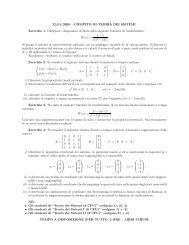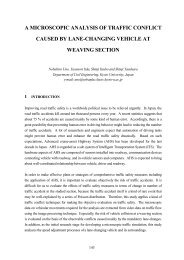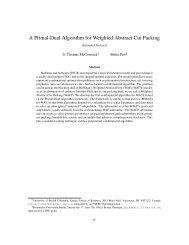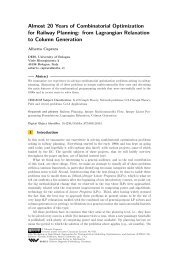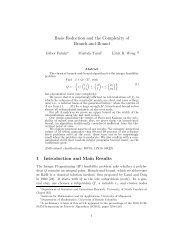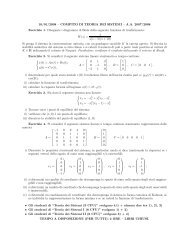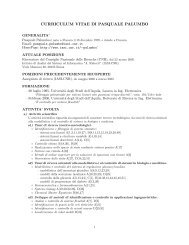Reverse Multistar Inequalities and Vehicle Routing ... - IASI-CNR
Reverse Multistar Inequalities and Vehicle Routing ... - IASI-CNR
Reverse Multistar Inequalities and Vehicle Routing ... - IASI-CNR
You also want an ePaper? Increase the reach of your titles
YUMPU automatically turns print PDFs into web optimized ePapers that Google loves.
The second situation, which is also motivated by a simple analysis of<br />
expression (6), is to consider variations of the CVRP where lower bound<br />
values on the arc flows are bigger than one. To illustrate such a situation,<br />
consider the so-called Balanced <strong>Vehicle</strong> <strong>Routing</strong> Problem (BVRP), where a<br />
minimum number of customers Q <strong>and</strong> a maximum number of customers Q<br />
are required to each route in a feasible solution. In general, the designation<br />
“balanced” applies to a variant of the problem when Q − Q is small. The<br />
BVRP is a particular version of the problem suggested <strong>and</strong> studied in [7]<br />
where besides the vehicle capacity bounds there are upper <strong>and</strong> lower bounds<br />
also for the length of the routes. A multiobjective optimization variant of<br />
this problem has been suggested <strong>and</strong> studied in [11] where the goal is to<br />
minimize the total route length as well as the difference between the longest<br />
route <strong>and</strong> the shortest route. In our paper we relax the condition that Q<br />
<strong>and</strong> Q should be close since our aim is to consider situations with a lower<br />
bound Q (> 1) <strong>and</strong> we may even allow examples where Q = |V | − 1 (i.e., no<br />
upper capacity on the vehicles). The lower limited capacity requirement can<br />
be easily modeled through a SCF model by setting the lower bound value<br />
q a on the arcs leaving the depot as being equal to Q. More precisely, a SCF<br />
model for the BVRP can be obtained by setting the parameters as follows:<br />
q a = q a = 0 for all a ∈ δ − (1)<br />
q a = Q <strong>and</strong> q a = Q for all a ∈ δ + (1)<br />
q a = 1 <strong>and</strong> q a = Q − 1 for all a ∈ δ + (1) ∪ δ − (1).<br />
Thus, it is quite easy to include lower bound information in a SCF formulation.<br />
On the other h<strong>and</strong>, finding from scratch inequalities involving only<br />
the xa variables to guarantee the minimum required number of customers<br />
in each route seems to be far from easy. Fortunately, the tool of projection<br />
applied on the SCF formulation permits us to obtain such set of inequalities.<br />
The MS inequalities are exactly the ones given in (7). Note that they do<br />
not depend on the lower bound value Q. The RMS inequalities, instead,<br />
take into account the upper bound capacity as well as the new lower bound<br />
capacity:<br />
Qx(1 : S) + x(S ′ : S) ≤ (Q − 1)x(S : S ′ ) + |S| for all S ⊆ V \ {1}. (8)<br />
These constraints guarantee that if a (partial) route does not have the<br />
minimum required number of customers, then it cannot be closed by connecting<br />
directly to the depot the two extremes of the route. This can easily<br />
be seen if we use the in-degree <strong>and</strong> out-degree equations (1) on the customer<br />
8


